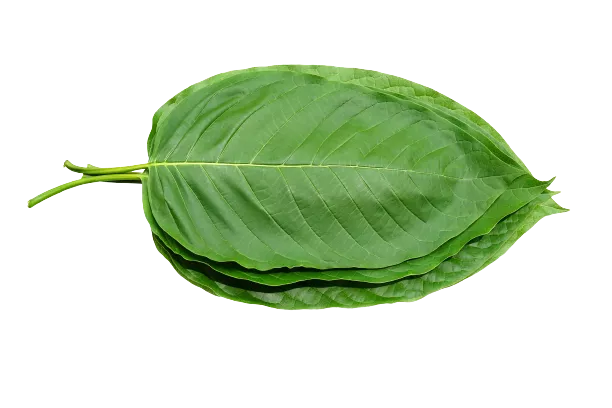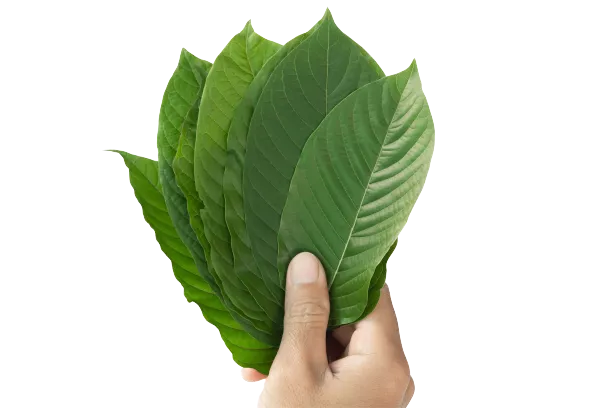What Is Kratom Extract?
Kratom extracts come in three forms: powder, tincture, and resin. These are concentrated forms of kratom and contain a higher alkaloid concentration than standard kratom powder. These alkaloids are extracted from the bulk material, either by osmosis (such as during a liquid extract), dissolution, or other methods.
Sometimes the alkaloids are produced synthetically and then added to standard kratom powder, producing an extract that doesn’t technically deserve the name but functions similarly.
When vendors don’t want to use synthetic mitragynine, extracts are made from large amounts of kratom. These extracts include all alkaloids instead of just mitragynine, making for a more complete-feeling product.
This is like comparing a full-spectrum cannabis extract to a plain-THC extract. The plain-THC extract might be significantly more potent and get you couch-locked; however, most cannabis connoisseurs will attest that single-cannabinoid extracts lack the depth and subtleties of a full-spectrum extract.
The best extracts start with high-quality kratom powder, so buy from a reputable vendor if you choose to buy one instead.
Why Bother Using & Making Extracts?
There are plenty of reasons you might want to use a kratom extract.
1. Less Plant Matter to Deal With
First, there’s much less volume of a product to deal with. A potent kratom extract can condense, for example, a kilogram of kratom powder into a couple of ounces.
2. Stronger Product
As users build a tolerance to kratom after daily usage, its effects dwindle. Responsible users recognize this as a clear sign to reduce their use before becoming addicted. Some people prefer to seek out more potent products because of the large amounts they may need and the simplicity in taking extracts.
3. Reduced Side Effects
Extracts can, in certain circumstances, reduce the frequency of certain side effects, although it’s wise to remember that the increase in potency also heightens the risk of other side effects.
The main side effects that extracts can nullify are digestive issues, some of which can be caused mechanically by consuming too much powder. Nausea, cramping, indigestion, and even the spins can result from the body struggling to process large amounts of indigestible kratom leaf fiber.
If you need high amounts of kratom to find relief, but this much powder makes you feel like throwing up, a single gram of 15x extract might provide you with relief without nausea. Your gut will thank you.
4. More Choice
One of the reasons you might want to make your extract at home is that, generally, only the most popular kratom strains are made into an extract. If you want to enjoy an extracted version of a particular strain, you might have to make it yourself.
5. You Decide the Potency
You can make your extract as strong or weak as you want, given that you have the right tools and equipment.
People often expect that financial savings are a good reason to spring for extracts, but unfortunately, this isn’t the case.
6. Save Money
Extracts tend to be far more expensive than the equivalent amount of kratom leaf. The processing and extraction processes involved require a great deal of time and effort, thus increasing costs.
Buying them might save you some time, but with a bit of planning, you can have an extract ready in no time — and save money. Kratom is often cheaper in bulk, so consider buying from a vendor offering these deals.

How to Make a Kratom Extract
As mentioned, there are a few different types of kratom extracts that you can make.
Making a Tincture
The first and most common DIY kratom extract is a tincture. All you need to make a kratom tincture is some kratom, hard liquor, and a container.
If you want to do it properly, you’ll want to gather the following:
- A scale for accurate dosing
- Kratom powder (this ‘recipe’ uses about 100 grams)
- Hard alcohol (80-100 proof or 40-50% alcohol should be plenty. If for some reason, you’re working with fresh kratom leaf, you’ll want to increase that to 60% or 70%)
- A mason jar to hold your kratom and alcohol
- Citric acid (not necessary, but allegedly helps to extract alkaloids from kratom)
- Glycerin (also not essential but can be useful)
- pH strips (if you choose to use citric acid)
- Cheesecloth or a fine mesh strainer
- Tincture dropper bottles
- Funnel with a small mouth
Here’s the basic technique.
- Measure out your kratom and alcohol. A good ratio is 1:4 kratom to liquor. If you measure out 100 grams of kratom, you’ll want 400 ml of alcohol.
- Pour the kratom into the mason jar, then the alcohol, and mix thoroughly. Use a wooden spoon to scrape any excess kratom off the sides of the jar.
- If you’re opting to use citric acid, add a little at a time until the pH level of your solution reaches four or lower. Citric acid might help convert some alkaloids into their salt forms, making them easier to extract.
- If you have glycerin, add it now to neutralize the acidity and break down the byproducts of oils and fats. After introducing the glycerin, shake the mixture until it becomes smooth.
- Let the tincture steep. There are several ways that you can do this. 1) Put the entire jar in a pot of hot water and let it sit until the water cools down. Repeat this several times. 2) Put the jar in a crockpot and set the temperature to low. You can leave it in from anywhere between a night and three days. Obviously, the longer it sits, the more alkaloids are extracted. 3) Let the jar sit somewhere cool and dark for a week or two, shaking periodically.
- Strain the mixture through cheesecloth or other fabric. Toss the leftovers.
- Return the liquid to the jar after rinsing it to clear away any matter.
- Evaporate the excess liquid to increase the potency. How much you evaporate is up to you, but remember, the more you evaporate, the stronger it will be. Speed evaporation up by leaving the jar somewhere warm. However, avoid direct heat over 220℉ to keep the alkaloids from degrading.

Making Water-Based Extracts
You’ve probably already tried making a water-based kratom extract. Most people call these types of extracts tea. However, in herbalism, teas are referred to as decoctions: water-based herbal extracts.
These extracts can be made incredibly strong by simmering the kratom for around half an hour with a squirt of lime juice. Straining is optional, but if you’re making tea with sufficiently large doses of kratom, you’ll probably want to strain it to avoid drinking any leftover kratom.
Remember, water-based tinctures don’t last as long as alcohol-based ones since the alcohol helps preserve them.
Making Kratom Resin
Kratom resin is a great way to enjoy reasonably large doses of kratom without dealing with the discomfort of gorging on large doses of powder.
Fortunately, making resin isn’t as hard as you might expect.
- Add your kratom powder to a jar, and then add just enough water to cover it. The resulting mixture should be thick and sludgy. Add a few squirts of lemon/lime juice, mix well, and let it sit overnight.
- Transfer to a freezer-proof container and freeze.
- Once it’s frozen, remove the frozen mixture and add to a saucepan with a liter of water.
- Add a few more squirts of lemon/lime juice and simmer the mixture for an hour or two, or long enough to evaporate about a quarter of the water.
- Let the mixture cool down, then strain the liquid into a separate saucepan. Continue simmering this on low to evaporate more water.
- Take the leftover powder and repeat the process from step 4. Do this at least once more, emptying the filtered water into the same saucepan each time.
- Simmer the water on low, evaporating until it becomes thick.
- Pour into a shallow and wide oven pan. The more surface area, the better.
- Place the pan in the oven set at 150-212℉. Remember that alkaloids begin to degrade at 220℉. Keep the oven door ajar and check every half hour or so.
- Scrape it off onto parchment paper once the resin reaches the desired consistency, preventing it from sticking to or greasing up anything else.
You can enjoy kratom resin in many ways. It dissolves very easily into hot water to make tea, though you’ll need some strong sweeteners to cover up the flavor. You can also swallow it raw for an intense experience.
Despite how similar kratom resin looks to opium, don’t bother trying to smoke it as it won’t work.

Kratom Extract Risks
It’s essential to be careful when using kratom extracts. Kratom is much less dangerous than opioids, but that doesn’t mean it’s entirely without risks.
Kratom extracts are notorious for being much riskier than standard power. Because these extracts are often so potent, the body can easily become overloaded with the various alkaloids found in kratom. Overdosing with kratom rarely happens, but it’s more likely for those new to extracts. Make sure you pay attention to the dose recommendations and calculate accordingly.
These compounds do not exist in such concentrations in the natural world. Therefore, the body can get overwhelmed to maintain balance while being bombarded by sedative and stimulant phytochemicals.
Side Effects
Kratom can cause short-term side effects like constipation, dizziness, nausea, and brain fog. Long-term users can also experience hormonal issues, liver problems, decreased libido, or addiction.
While extracts can reduce some side effects like nausea, they can also increase the likelihood of others because of their potency. It’s easy to take too much, which is even more of a problem if you make an extract and miscalculate the dosage.
Addiction
Potent extracts are easier to become addicted to. If you know the signs of addiction and use kratom properly, you keep these problems at bay.
There are ways to work around nearly all of the side effects caused by drugs. However, using these workarounds is the same as ignoring the warning signs that would otherwise protect you from becoming addicted.
You can avoid this dangerous cycle with a bit of willpower and self-awareness. When you feel the side effects of kratom, you’ll have to bite the bullet and cut back. This might be uncomfortable, and you might experience cravings. Trust, though, that this is much better than developing an addiction.
If you can psychologically prepare yourself for cravings, you might even appreciate them, recognizing them as positive indicators or milestones towards maintaining or decreasing your kratom habit.

Final Thoughts on DIY Kratom Extracts
Kratom is a great herb, but sometimes it can be a chore figuring out how to get the powder into your body in a least-disgusting way. Kratom extracts are a great way to navigate around this unpalatable issue.
Water-based extracts (also known as tea), tinctures, and even resin and powder extracts are relatively simple to make at home. Doing this can increase your enjoyment of kratom and may help you regulate your usage better.

